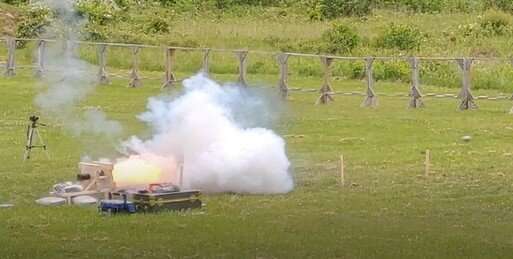Blowing up medieval gunpowder recipes

First used for battle in China in about 900 A.D., gunpowder spread throughout Eurasia by the end of the 13th century, eventually revolutionizing warfare as a propellant in firearms and artillery. Meanwhile, master gunners tinkered with gunpowder formulas, trying to find the ideal concoction. Now, researchers reporting in ACS Omega have recreated medieval gunpowder recipes and analyzed the energies released during combustion, revealing that the evolution of the perfect powder was a slow, trial-and-error process.
Although largely obsolete in modern weaponry, gunpowder, also known as black powder, is still used in historical weapons, fireworks and pyrotechnics. The explosive is a combination of varying ratios of potassium nitrate (or "saltpeter"), sulfur and charcoal. Medieval recipes sometimes included interesting additives, such as camphor, varnish or brandy, with obscure purposes. Dawn Riegner, Cliff Rogers and their team of chemists and historians wanted to analyze the energetics of medieval gunpowder recipes to help understand the intent of master gunners in creating these formulas, as well as to provide important technical information about early gunpowder manufacturing.
To do this, the researchers identified over 20 gunpowder recipes from medieval texts dated 1336 to 1449 A.D. They prepared the powders and measured the energies released just before and during combustion using differential scanning calorimetry and bomb calorimetry. They also tested a few of the recipes at a West Point firing range using a replica of an early 15th-century stone-throwing cannon.
In general, in the period 1338–1400 A.D., the percentage of saltpeter increased and charcoal decreased, causing lower heats of combustion, which could have produced safer recipes for medieval gunners. After 1400 A.D., the percentage of saltpeter (the most expensive ingredient) decreased slightly, while sulfur and charcoal increased, raising the heat of combustion, although not as high as for the earliest recipes. Certain additives, such as the combination of camphor and ammonium chloride, appeared to make gunpowder stronger, whereas others, such as water or brandy, did not show energetic advantages, but might have served other purposes. For example, they might have made the material more stable during transport or storage. Although the researchers have characterized the gunpowders in the lab and in limited experiments on the firing range, more field work must be done to evaluate which formulation would perform the best in historical contexts, they say.
More information: Tessy S. Ritchie et al, Evolution of Medieval Gunpowder: Thermodynamic and Combustion Analysis, ACS Omega (2021). DOI: 10.1021/acsomega.1c03380
Journal information: ACS Omega
Provided by American Chemical Society





















